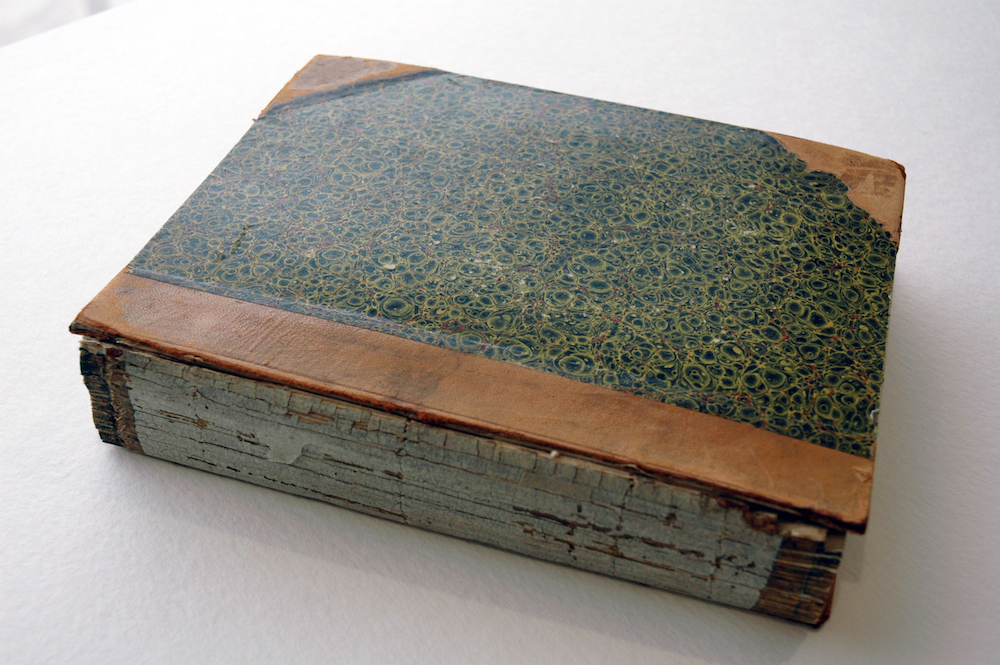Preservation Treatments
Preservation Rehousing of the Doves Bible (1893)
T. J. Cobden-Sanderson and the Legacy of the Doves Press
T. J. Cobden-Sanderson was a late-nineteenth-century English barrister who gave up the law to participate in the Arts and Crafts movement. In 1893, he founded the Doves Bindery to produce simple and ornate bindings for William Morris's Kelmscott Press. With Emery Walker, Cobden-Sanderson established the Doves Press in Hammersmith in 1900 where the partners designed and cast the Doves Type. Based on humanist types used during the Renaissance by Nicolas Jenson, this font was used to print the Doves Bible on handmade paper from 1902 to 1904. Completed when Cobden-Sanderson was 64, the Doves Bible's simple elegance still represents the apex of the Private Press movement.
The Marriott Library's copy of the Doves Bible was stored in it's original non-archival clamshell box that was falling apart. In order to ensure its safe storage and long-term preservation, a new archival clamshell box was designed and made for the bible. This box would not only protect the precious book, but also keep a portion of the original clamshell box for researchers. While making a box sounds simple, many aspects have to be taken into consideration including the aging qualities of the materials used, the chemical and physically stabilities of these materials, the weight of the box, areas that may cause abrasions or damage to the object, ease of removal etc.
Preservation housing designed and made by Frank Pester, Book Conservation Technician
Conservation Treatment of The Practical Cook Book Mrs. Bliss (1887)
A Preservation Success Story
Most likely from repeated use in the kitchen over the years, The Practical Cook Book was no longer intact. The front and back covers had broken off, the signatures had separated, and the spine was lost. Because of it's unstable condition, it was not safe for patrons to handle this delicate book, and it was sent to Preservation to be treated.
Treatment for this beautiful book of 19th century recipes, from the Marriott Library's Rare Books collection, started with cleaning and mending the torn pages, supporting the signatures that comprise the text, and re-sewing these signatures back together. A new spine was made with archival materials that are chemically stable and age well. The spine was toned with acrylics to match the original color, and attached to the front and back covers. The repaired textblock and cover were then reunited using cloth and paper hinges. Now, these old recipes are ready to be perused by the curious cook!
Treatment by Susan Schlotterbeck, Book Conservation Technician
Conservation treatment of Methodum Peculiarem Elevationem by Carl Friedrich Gauss
From Damage to Durability
A bound volume of 17 monographs by the 19th century German mathematician Carl Friedrich Gauss came to Preservation with serious condition issues. The monographs had been bound into a single volume at a later date. Due to unknown previous storage conditions, the book was heavily damaged from mold, and the pages were so fragile they felt like pieces of tissue. Furthermore, an unknown individual had tried to stabilize the book by adhering pieces of paper over fragile areas with PVA. These repairs caused serious cockling of the original leaves, and made them inflexible and prone to tearing around the repairs.
In addition to the conservation treatment needed to stabilize the book, the Rare Books curator desired that the monographs, written over a period of approximately 30 years, be bound individually for better cataloguing.
Repair involved disbanding the book to its individual folios, followed by dry cleaning using a HEPA-vacuum in a fume hood, and soot sponges, to remove dried mold spores and friable mold residue from the pages. The old repairs were removed using solvent baths that solubilized the adhesive, allowing the papers to be gently peeled away without harming the original material. The pages were resized to restore some strength and flexibility, and then repaired. Some of the more degraded pages were lined for additional support.
The individual monographs were resewn with a sympathetic period-style paper, using an according guard on the spine to protect the original paper from moisture from adhesive, and an internal guard to provide additional sewing support. Each monograph was bound in a flat-spined case. This once too-fragile-to-handle book can now be examined safely.
Treatment by Jeff Hunt, Book Conservator and Stacey Kelly, Paper Conservator








